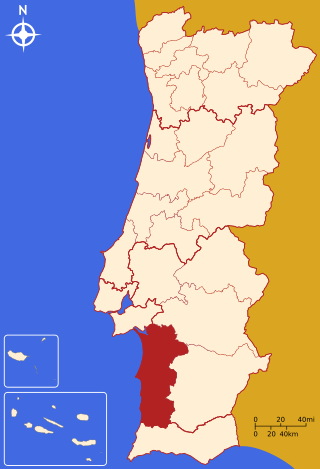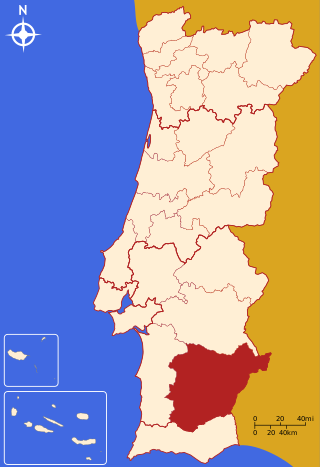Alentejo is a geographical, historical and cultural region of Portugal.
Alentejo may also refer to:

The Ribatejo is the most central of the traditional provinces of Portugal, with no coastline or border with Spain. The region is crossed by the Tagus river. The region contains some of the nation's richest agricultural land, and it produces most of the animals used in the Portuguese style of bullfighting.

Sines is a town and a municipality in Portugal. The municipality, divided into two parishes, has around 14,214 inhabitants (2021) in an area of 203.30 km2 (78.49 sq mi). Sines holds an important oil refinery and several petrochemical industries. It is also a popular beach spot and the main fishing harbour of Alentejo region.

The Rafeiro do Alentejo is a Portuguese breed of livestock guardian dog. It is named for its area of origin, the Alentejo region of southern Portugal. It is recognised by the Clube Português de Canicultura, and was definitively accepted by the Fédération Cynologique Internationale in 1954.

Alentejo is a Portuguese wine region from the Alentejo region. The entire region is entitled to use the Vinho Regional designation Alentejano VR, while some areas are also classified at the higher Denominação de Origem Controlada (DOC) level under the designation Alentejo DOC. VR is similar to the French vin de pays and DOC to the French AOC. In the southern half of Portugal, the Alentejo region covers about a third of the country and is sparsely populated. In 2005, South Oregon University scientist Gregory V. Jones identified Alentejo as the world's most challenged wine region from a climate change perspective. The region is noted for it vast cork production but has in recent years garnered attention for its table wine production. Some producers of this region still make wine in great pottery vessels, as in Roman times.

The Comunidade Intermunicipal do Alentejo Central is an administrative division in Portugal. It was created in 2009. The seat of the intermunicipal community is Évora, the main city. Other cities are Estremoz, Montemor-o-Novo, Vendas Novas and Reguengos de Monsaraz. Alentejo Central is coterminous with the former Évora District. The population in 2011 was 166,726, in an area of 7,393.46 km2.

Tourism in Portugal serves millions of international and domestic tourists. Tourists visit to see cities, historic landmarks, enjoy beaches, or religious sites. As of 2019, Portugal had 27 million visitors. The most popular destinations were Lisbon, Porto, the Algarve, the Portuguese Riviera, Madeira, Sintra, Óbidos and Fátima. The most popular with internationals were Lisbon, the Algarve and Northern Portugal. National tourists prefer Northern Portugal, followed by Central Portugal and the Algarve.

Açorda is a traditional Portuguese dish composed of cubed or sliced stale bread with garlic, coriander, and poached eggs. It is a type of bread soup, although some variants have a consistency closer to that of a porridge.

The Castle of Viana do Alentejo is a gothic castle constructed during the reconquest and settlement of the central region of the Portuguese Alentejo, located in the parish of Viana do Alentejo, municipality of the same name. Although a relatively low-profile design, in comparison to its contemporaries, the structure served the period of strife associated with expansion of Portuguese forces/authority into the southern Algarve.

The Comunidade Intermunicipal do Alentejo Litoral is an administrative division in Portugal. It was created in May 2009. It is also a NUTS3 subregion of the Alentejo Region. The seat of the intermunicipal community is Grândola. Alentejo Litoral comprises municipalities of both the Beja District and the Setúbal District. The population in 2011 was 97,925, in an area of 5,309.41 km2.

The Comunidade Intermunicipal do Alto Alentejo is an administrative division in Portugal. It was created in 2009. The seat of the intermunicipal community is Portalegre. Alto Alentejo is coterminous with the former Portalegre District. The population in 2011 was 118,506, in an area of 6,084.34 km2. Together with Alentejo Central it covers the area of the former Alto Alentejo Province. With Ponte de Sor the intermunicipal community also includes one municipality that lies in the area of the former Ribatejo Province.

The Comunidade Intermunicipal do Baixo Alentejo is an administrative division in Portugal. It was created in 2009. It is also a NUTS3 subregion of the Alentejo Region. The seat of the intermunicipal community is Beja. Baixo Alentejo comprises 13 of the 14 municipalities of the Beja District. The population in 2011 was 126,692, in an area of 8,542.72 km2.
Baixo Alentejo may refer to:

Évora is a city and a municipality in Portugal. It has 53,591 inhabitants (2021), in an area of 1,307.08 square kilometers (504.67 sq mi). It is the historic capital of the Alentejo and serves as the seat of the Évora District.

Alentejo Region is one of the seven NUTS 2 regions of Portugal. It covers all of the historical Alentejo Province and part of the historical Ribatejo and Estremadura provinces.
Alvalade is a freguesia in the municipality of Lisbon, Portugal.
Campo Maior may refer to:
Castle of Cola is an Iron Age residence and Islamic redoubt in the Portuguese Alentejo, classified as a National Monument. The castro is part of a larger archaeological park of Castro da Cola, that includes various Megalithic and Chalcolithic monuments, including necropolises of the Bronze and Iron Ages. The Castro-era polygonal plan, included reinforced blocks, with an entrance controlled by tower. The remaining defensive structure was circled by walls, with still exist, on the neighboring pasture-lands protecting the castle.

Alentejo is a geographical, historical, and cultural region of south–central and southern Portugal. In Portuguese, its name means "beyond the Tagus river" (Tejo).
The Castle of Montalvão is a medieval castle in the civil parish of Montalvão, municipality of Nisa, in the Portuguese district of Portalegre.

Comporta, also known as the Comporta Coast, is a region in the northwestern coast of the Alentejo, in Portugal, south of the Lisbon metropolitan area. Comporta is one of the most exclusive summer destinations in Europe, which has earned the region the nickname as "the Hamptons of Europe". The region, which takes its name from the village of Comporta, spans the coastal areas of the Alentejan municipalities of Alcácer do Sal and Grândola.